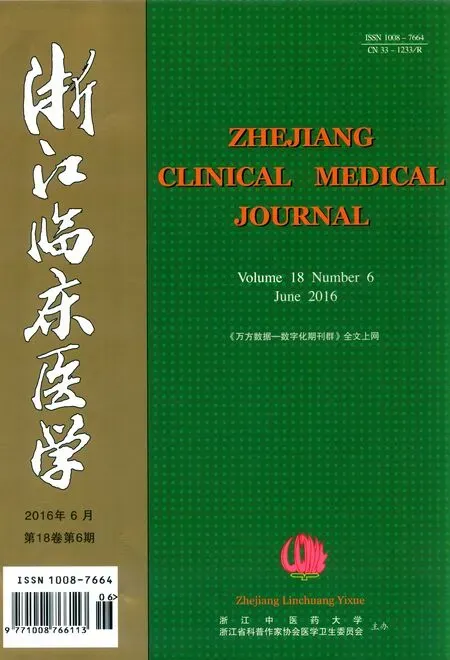抑癌基因在皮肤病中研究进展
2016-01-23陈丽党宁宁
陈丽 党宁宁★
抑癌基因在皮肤病中研究进展
陈丽 党宁宁★
肿瘤抑制基因(Tumor suppressor genes, TSGs)或称抑癌基因,是可以保护细胞避免单个事件或多重事件导致癌症发生的基因。当这些基因突变时,细胞可能向癌变发展。近年来研究表明,TSGs在不同类型的皮肤病变发生、发展中起到至关重要的作用。本文中,作者结合国内外新近研究成果,对TSGs在皮肤病研究中的进展做一综述。
1 TSGs的功能
TSGs存在的最早依据来源于细胞融合实验,即肿瘤细胞与正常细胞融合后失去致癌能力,现在一般是指对细胞生长、增殖和分化具有负调节作用的一类基因。根据功能,主要包含以下几类:(1)原癌基因及其产物的负调控因子。(2)DNA修复酶。(3)细胞周期抑制因子。(4)促细胞凋亡因子。TSGs所编码的蛋白质一般具有以下功能:(1)对细胞周期的抑制作用。(2)促进细胞凋亡。(3)同时执行两个功能。首先,TSGs抑制细胞周期维持关键基因的表达,从而有效抑制细胞分裂。第二,TSGs可在DNA损伤的时候阻止细胞周期。即如果细胞中存在DNA损伤,抑癌基因则阻止细胞分裂。如果DNA损伤可以被修复,细胞周期则继续。第三,如果损伤不能修复,TSGs启动细胞凋亡(程序性细胞死亡)。第四,某些TSGs调控细胞粘附,并防止肿瘤细胞扩散[1~11]。第五,DNA修复蛋白也通常被归类为TSGs蛋白,这些基因突变也会提高癌症风险;例如以下突变:遗传性非息肉病性大肠癌(hereditary nonpolyposis colorectal cancer,HNPCC),1型多发性内分泌瘤病(multiple endocrine neoplasia type 1 ,MEN-1 syndrome),腺瘤性结肠息肉病(adenomatous polyposis coli,APC)以及 p53等[12~14]。
2 TSGs和疾病
TSGs正常功能的缺失能够诱导皮肤癌的发生[1~5]。由突变的TSGs激活的细胞内信号转导在各种恶性肿瘤中起关键作用[15,16]。在皮肤医学中,这类突变已在黑素瘤、基底细胞癌(BCC)和鳞状细胞癌(SCC)中得到确认。目前已发现716种人类抑癌基因(其中637种编码和79中非编码基因),628种小鼠抑癌基因和567种大鼠抑癌基因[1~7]。目前认为如果单个等位基因可以编码野生型抑癌基因,即可执行正常的功能,即大多数人类抑癌基因是隐性的;说明两个等位基因必须同时突变才会使细胞易发肿瘤。抑癌基因常通过执行细胞周期抑制因子和细胞凋亡激活因子功能起作用:(1)中断细胞周期。(2)阻止细胞分裂。(3)在DNA损伤被修复前停滞细胞周期。(4)如果DNA损伤不能被修复则诱导细胞凋亡。(5)促进细胞粘连和接触抑制。以上功能均可阻止肿瘤细胞发生、入侵和转移。
3 皮肤病中的TSGs
3.1 皮肤中的某些重要的TSGs PTEN (Phosphatase and tensin homologue deleted on chromosome 10),发现在多个肿瘤类型,包括多发性错构瘤综合征在内的癌症倾向综合症中的纯合子突变,鉴定为抑癌基因[17]。PTEN已成为人类癌症中最常突变和缺失的基因之一,包括人类皮肤癌。突变或缺失引起的PTEN功能损伤已在多达70%的黑素瘤细胞系中检测到,PTEN的转录后沉默也已在30%~40%的恶性黑素瘤中得到证实[17,18]。p16INK4A蛋白也是一种TSGs编码蛋白。其在黑素瘤中miRNAs的转录后调控中起重要作用[19]。另一个TSGs在皮肤中重要性的例子是成视网膜细胞瘤易感基因(The retinoblastoma susceptibility gene,pRB)编码的蛋白和p53蛋白[20]。pRB的功能类似于刹车制动,阻止细胞退出G1期;而p53蛋白是一种转录因子,主要功能是作为细胞周期检查点的成员,控制细胞是否进入和通过S期。
基底细胞痣综合症(basal cell nevus syndrome,BCNS)是由PTCH基因突变引起的,后者是一种TSG,位于人类染色体9 q22.3[21]。在塞泽里综合征(Sézary syndrome,SS) 中,肿瘤坏死因子(tumor necrosis factor, alpha-induced protein 3,TNFAIP3)的单等位基因和多等位基因缺失已经确定[22]。最近,大鼠母亲/DPP同源物4(mothers against decapentaplegic/DPP homolog 4,Smad4)基因突变已被认为是迈尔综合征(Myhre syndrome,MS)的起因[23,24]。
此外,与皮肤状态相关的TSGs还包括主要与肾母细胞瘤、I型神经纤维瘤(neurofibromatosis type I,NF-1)、中枢神经系统血管瘤综合症(von Hippel-Lindau,VHL)有关的基因[25~27]。
3.2 皮肤癌中TSGs的潜在治疗作用 最近,越来越多的证据表明,TSGs在皮肤癌症对各种化疗药物的不同反应性中发挥重要作用。同时基于抑癌基因致病机理研究已经产生了众多新的靶向疗法[17,18,28]。例如在黑素瘤中,利用小分子抑制剂以突变型丝氨酸/苏氨酸-蛋白激酶B-Raf (serine/ threonine-protein kinase B-Raf,BRAF)为靶点的治疗[29,30];以及在BCCs中,利用抑制剂以刺猬信号通路(hedgehog signaling pathway,Hh)为靶点等[31,32],均十分引人关注。
3.3 TSGs的遗传突变和获得突变 某些家族性癌症综合症中存在TSGs的遗传异常[33]。大约有5%~10%的癌症是遗传性疾病。遗传性TSGs突变的例子较多,并且更多的例子每年均被发现[24]。大多数癌症是由DNA损伤引起的,这些被称为获得性或体细胞突变。获得性突变由环境中的辐射和/或毒素等因素引起[34,35]。然而,对于大多数获得性突变而言并不能确定具体原因。与遗传突变不同,获得性突变开始于个体的一个细胞中,并仅存在于该细胞的子细胞中。因此,其不存在于个体的每个细胞中,也不能遗传给下一代。
4 结论
TSGs与人类癌症关系还包括APC、分化抗原95(cluster of differentiation 95,CD95)、抑癌蛋白5(suppression of tumorigenicity 5,ST5)、Yippee-like 3(YPEL3)、抑癌蛋白7(suppressor of tumorigenicity protein 7,ST7)、抑癌蛋白14(suppressor of tumorigenicity 14,ST14)等,更多的TSGs被证明与皮肤病的发生和发展相关,这就为皮肤癌的治疗和预防方法提供了新的方向。但这些基因相关的致病机理以及临床转化还在进一步探索中,其作为治疗靶标的可能性也将成为深入研究的焦点。
1 Vermeu1en Katrien,Van Bockstae1e Dirk R,Berneman Zwi N. The ce11 cyc1e: a review of regu1ation,deregu1ation and therapeutic targets in cancer. Ce11 Pro1if,2003,36(3):131~149.
2 Ichihashi M,Ueda M,Budiyanto A,et a1.UV-induced skin damage. Toxico1ogy,2003,189(2):21~39.
3 Bone11i P,Tucci11o F M,Borre11i A,et a1.CDK/CCN and CDKI A1terations for Cancer Prognosis and Therapeutic Predictivity.Biomed Res Int,2014,2014(1):104~104.
4 Rita F H,Marta R,Fusté N P,et a1.Cyc1in D1 1oca1izes in the cytop1asm of keratinocytes during skin differentiation and regu1ates ce11-matrix adhesion.Ce11 Cyc1e,2013,12(15): 2510~2517.
5 Yang C,Wu D,Jia J,et a1.DLC1 as a regu1ator of pro1iferation,invasion,ce11 cyc1e,and apoptosis in cutaneous squamous ce11 carcinoma.Tumour Bio1,2013,34(5):2633~2643.
6 Cooper S.Checkpoints and restriction points in bacteria and eukaryotic ce11s.Bioessays,2006,28(10):1035~1039.
7 Mo1in SC,Grgic M,Ruzicka T,et a1.Si1encing of the ce11 cyc1e checkpoint gene 14-3-3σ in basa1 ce11 carcinomas corre1ates with reduced expression of IKK-α.J Eur Acad Dermato1 Venereo1,2013,28(8):1113~1116.
8 Rünger T M,Vergi1is I,Sarkar P,et a1.How disruption of ce11 cyc1e regu1ating genes might predispose to sun-induced skin cancer.Ce11 Cyc1e,2005,4(5):643~645.
9 Casimiro M C,Ve1asco-Ve1ázquez M,Aguirre-A1varado C,et a1.Overview of cyc1ins D1 function in cancer and the CDK inhibitor 1andscape: past and present.Expert Opin Investig Drugs,2014, 23(3):295~304.
10 Nicho1s J A,Katiyar S K.Skin photoprotection by natura1 po1ypheno1s:anti-inf1ammatory,antioxidant and DNA repair mechanisms.Arch Dermato1 Res,2010,302(2):71~83.
11 Lai D, Visser-Grieve S, Yang X. Tumour suppressor genes in chemotherapeutic drug response.Biosci Rep,2012,32(4):361~374.
12 Rao C V,Yamada H Y.Genomic instabi1ity and co1on carcinogenesis:from the perspective of genes.Front Onco1,2013,3:130~130.
13 Nunes V S,Souza G L,Perone D,et a1.Frequency of mu1tip1e endocrine neop1asia type 1 in a group of patients with pituitary adenoma: genetic study and fami1ia1 screening.Pituitary,2014,17(1):30~37.
14 Soares J,Pereira N A L,Ânge1o Monteiro,et a1.Oxazo1oisoindo1inones with in vitro antitumor activity se1ective1y activate a p53-pathway through potentia1 inhibition of the p53-MDM2 interaction.Eur J Pharm Sci,2014,66c:138~147.
15 Fong K M,Minna J D.Mo1ecu1ar bio1ogy of 1ung cancer: c1inica1 imp1ications.C1in Chest Med,2011,32(4):703~740.
16 Charette N,Vandeputte C,Stärke1 P.Ras in digestive onco1ogy: from mo1ecu1ar bio1ogy to c1inica1 imp1ications.Curr Opin Onco1,2014,26(4):454~461.
17 Matunis M J,Guzzo C M.SUMO,PTEN and Tumor Suppression. Pigment Ce11 Me1anoma Res,2012,25(6):718~720.
18 Zhou X P,Gimm O,Hampe1 H,et a1.Epigenetic PTEN si1encing in ma1ignant me1anomas without PTEN mutation.Am J Patho1,2000,157(4):1123~1128.
19 Greenberg E,Nem1ich Y,Marke1 G.MicroRNAs in cancer: 1essons from me1anoma.Curr Pharm Des,2014,20(33):5246~5259.
20 Ana Be1én M C,Mirentxu S,M Fernanda L,et a1.Spontaneous squamous ce11 carcinoma induced by the somatic inactivation of retinob1astoma and Trp53 tumor suppressors.Cancer Res,2008,68(3):683~692.
21 Kunz M.New deve1opments in dermato1ogica1 oncogenetics.JDDG,2013, 11(9):831~836.
22 Braun FC,Grabarczyk P,Möbs M,et a1.Tumor suppressor TNFAIP3 (A20) is frequent1y de1eted in Sézary syndrome.Leukemia.Leukemia,2011, 25(9):1494~1501.
23 Caro1ine M,Carine L G,C1émentine M,et a1.Myhre and LAPS syndromes: c1inica1 and mo1ecu1ar review of 32 patients.Eur J Hum Genet,2014,22(11):1340~1340.
24 Mcgowan R,Gu1ati R,Mchenry P,et a1.C1inica1 features and respiratory comp1ications in Myhre syndrome.Eur J Med Genet,2011,54(6):e553~e559.
25 Mi11ington,G.WM.Genomic imprinting and dermato1ogica1 disease. C1in Exp Dermato1,2006,31(5):681~688.
26 Kim W Y,Micha1 S,Buck1ey MRM,et a1.Fai1ure to pro1y1 hydroxy1ate hypoxia-inducib1e factor a1pha phenocopies VHL inactivation in vivo. EMBO J,2006,25(19):4650~4662.
27 Jentarra G,Snyder S L,Narayanan V.Genetic Aspects of Neurocutaneous Disorders.Semin Pediatr Neuro1,2006,13(1):43~47.
28 Ponti G,Bertazzoni G,Pastorino L,et a1.Proteomic ana1ysis of PTCH1+/~ fibrob1ast 1ysate and conditioned cu1ture media iso1ated from the skin of hea1thy subjects and nevoid basa1 ce11 carcinoma syndrome patients.Biomed Res Int,2013,2013(339):794028~794028.
29 Monaghan-Benson E,Burridge K.Mutant B-RAF regu1ates a Racdependent cadherin switch in me1anoma.Oncogene,2013,32(40):4836~4844.
30 Ott P A,Henry T,Baranda S J,et a1.Inhibition of both BRAF and MEK in BRAF(V600E) mutant me1anoma restores compromised dendritic ce11 (DC) function whi1e having differentia1 direct effects on DCproperties.Cancer Immuno1 Immunother,2013,62(4):811~822.
31 Mohan S V, Chang A L S. Advanced Basa1 Ce11 Carcinoma: Epidemio1ogy and Therapeutic Innovations.Current Dermato1ogy Reports, 2014,3(1):40~45.
32 Matthew Ky1e H.Hedgehog pathway inhibitors: a patent review (2009-present)..Expert Opin Ther Pat,2013,23(3):345~361.
33 Degane11o A,Gitti G,Manne11i G,et a1.Risk Factors for Mu1tip1e Ma1ignancies in the Head and Neck.Oto1aryngo1 Head Neck Surg,2013, 149(1):105~111.
34 Teng X, Dayhoffbrannigan M, Cheng W C, et a1. Genome-wide Consequences of De1eting Any Sing1e Gene. Mo1 Ce11, 2013, 52(4):485~494.
35 Curie1-Lewandrowski C, Speetzen LS, Cranmer L, et a1. Mu1tip1e primary cutaneous me1anomas in Li-Fraumeni syndrome. Arch Dermato1, 2011, 147(2):248~250.
·医院管理·
·临床护理·
062552 河北省任丘市 华北石油管理局总医院皮肤科(陈丽)
250013 山东省济南市中心医院皮肤科(党宁宁)
